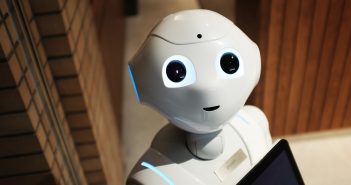Like most men in the world, shopping (especially shopping for clothes) is an unpleasant experience for me, as I really feel like my time could be much better utilised. I make it a personal mission to get in and out in minimal time. So, I wonder to myself, “Could AI make my experience better?” OK, maybe it won’t turn me into a shopaholic. But I think there’s a lot of potential for retailers to use AI to improve my shopping experience and make sure that I find what I need as quickly as possible, ensuring that I shop more frequently.
Pleasant shopping experiences
Amazon recently opened Amazon Go in Seattle, which takes shopping to a whole new level. It provides a checkout-free experience for its customers. There are no cashiers at all. Customers simply walk in, take what they like off the shelves and walk out; it’s as simple as that.
Many retailers are looking to replicate this concept, which will have massive benefits such as removing customer friction points (long queuing times, lack of cashiers) and minimising labour costs.
Consider the evolution of how customers started making payments at retailers. It’s gone from cash to credit card to mobile payment, and now totally automated.
Amazon uses cameras and machine learning algorithms to identify customers that walk into the store and items they pick. It can even detect if a customer has picked an item and decided to put it back on the shelf.
All that is required is for customers is to have an Amazon account and the Amazon Go app on their mobile phones. When customers walk in, they scan the app at the electronic readers at the turnstile and start shopping. Machine learning algorithms know exactly what they have picked and the customer is charged appropriately.
Thanks to major improvements in computing power and new algorithms, computer vision and natural language processing are making massive strides. In my view, though, this is just the tip of the iceberg: a tiny fraction of what can actually be done. Facial recognition is certainly not new, but retailers are using it in new ways, such as identifying age and other characteristics.
Cameras are also being used in new ways. Retail stores are using cameras to track when customers enter their stores and how they behave when they are there. By understanding how customers behave in the stores, insights from this data are used to improve store layout, encourage customers to stay longer and visit more often.
Consider the type of behaviour that can be captured and analyzed using video cameras. For example, a customer is window browsing and eventually goes into the shop. He then goes to an aisle/certain section and spends a considerable amount of time there. Retailers are using this rich data and optimise the store layout to make customers spend more time and also visit more frequently.
Smart inventory management
Recently I had the laborious task of home renovation and had to go shopping around for items such as tiles, fittings, etc. A painful experience indeed since almost all the things I wanted to buy were out of stock. Yet they were still on display, which made it more frustrating.
Retailers are using advanced analytics and forecasting to accurately forecast and optimise inventory levels. Some are even looking at real-time tracking of inventory in stores and monitor which items are out of stock. The idea is to quickly replenish stock, thus massively improving the customer experience.
Robots are also being used to stock shelves optimally to ensure a pleasant customer experience.
Beyond the buzz of what artificial intelligence can do, how will AI change companies and the way they are managed? Learn more from this HBR collection.
Chatbots to personalise shopper experience

Chatbots use natural language processing and AI so us humans can have intelligent conversations with them. Retailers are using personal shopping assistants (essentially bot technology) to provide a more tailor-made experience for customers. AI-driven bots can help shoppers find exactly what they are looking for, in the right style, colour and size – and can even make personalised recommendations based on a few simple questions.
What are the tangible benefits of AI in retail?
So why should South African retailers consider implementing artificial intelligence? There are significant costs and technical challenges associated with AI. Do the benefits outweigh the costs?
Well, in my opinion, there are some very tangible benefits that retailers can extract almost immediately. Global retailers can:
- Increase revenue (and reduce inventory costs) by being able to better meet customer demand through having the right products available in the right locations.
- Increase sales by offering real-time and relevant offers to customers through the device or channel that they prefer to use, such as a mobile app or delivered through a chatbot.
And in the age of the customer, intangible benefits such as improvements in customer experience are one of the most important reasons to consider artificial intelligence. AI helped Amazon to remove some of the major friction points in the buying journey by removing till queues and taking away payment delays.
While South African consumers may still wait awhile for the first Amazon Go store, SA retailers should already be considering how AI can help them to gain a competitive advantage in these difficult economic times.


3 Comments
You might be interested to know about the Personal Stylist Meets Artificial Intelligence For a Menswear Subscription Box... a new way of shopping... https://www.forbes.com/sites/forbes-finds/2018/04/02/personal-stylist-meets-artificial-intelligence-for-this-menswear-subscription-box/#3fe9bf7a142d
Thanks, this is very relevant
Retail industry is going through a transformation. An AI Driven approach will help retail industry compete on an equal footing regardless of the size of your company. Ai in retail is the next big thing. Here is how Actionable Science can help